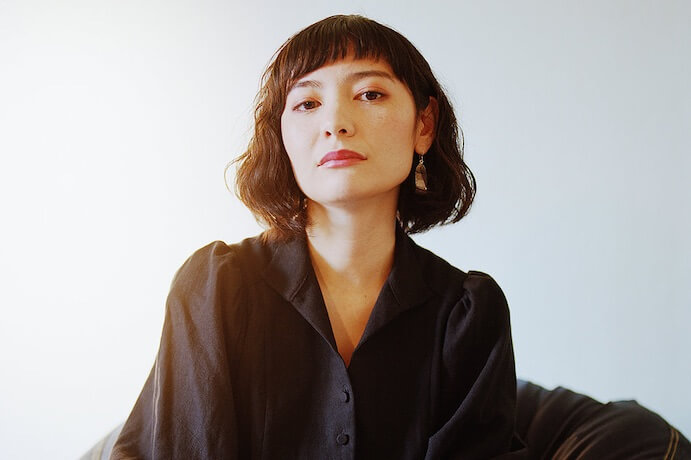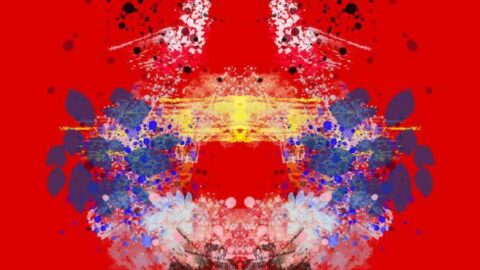In the first few seconds, Card II grips the listener, utilizing a blend of percussion, drum machine, and synthesizers to explore the variety of musical influences at the core of percussion duo NOMON. Their debut EP is brief, but showcases their distinct and unapologetic creative instincts as sisters Shayna and Nava Dunkelman design seemingly endless layers of electronics, blurring time by swirling through ambient forms and driving beats.
While the influence of experimental, industrial, contemporary, and electronic music are quickly apparent, NOMON offers more to the music. Subtle influences from Shayna and Nava’s diverse musical training offer depth that keeps the listener enthralled through multiple listens. With the sisters growing up in Tokyo and living on both coasts of the U.S., the cultural exchange of concepts such as time, structure, and movement combine to construct a truly unique body of work. The title of the EP, Card II, refers to one of the ten inkblot prints used on the Rorschach test, and the inspiration stems from the Rorschach-like percussion set-up they use to accentuate the choreographic nature of performing.

“Kaeda” opens the album, where the sisters’ interest in the physicality of performance is heard through exceptional production work. The imagery of the Rorschach card is immediately obvious as the metallic rhythmic motives of cymbals move from one performer panned stereo left to the other panned right. As the duo’s rhythms grow more intricate and the multitude of constantly moving electronic colors and pulsations fill the environment, the nuances of multicultural musical training intuitively inform the work’s progression.
The simple synth melody that begins “Kaeda” is the only thing that clearly repeats with minimal modifications, giving an unusual sense of structure. Rhythmic patterns shift through various timbres, and slowly modulating synths and heavy percussive grooves don’t follow expectations as they grow to a peak only to vanish into a single sparse and stagnant idea. The delicate act of crafting so much constantly progressing material risks becoming overwhelming to the listener, but Shayna and Nava manage this deftly, weaving together a fierce introduction.

Shayna and Nava’s more subtle musical influences are most apparent in “Hana,” as the duo’s unique sense of space and progression shine. The meditative quality of seemingly processed Tingsha Bells and drum machine set a simple ambiance that distracts the listener into a calming lull, yet NOMON proceeds to slowly unravel small complexities. The duo boldly holds onto sounds far beyond expectation to reveal intricacies like accelerating polyrhythmic shifts, moving each sound event from an exciting color to a necessary part of the structural progression. The work’s atmosphere boasts an inventive acumen through the arrangement of material in prolonged forms. As Shayna and Nava add layer after layer of well-conceived acoustic and synth timbres, the precise performance and visceral sense of time keep each distinct voice of the multi-linear texture clear.
While other works showcase creative structures and detailed textures, NOMON uses the straightforward form of “Kirie” to highlight their dexterity and finesse as performers. The necessity for recognizable patterns is crucial in many forms of music: while the Euro-classical tradition often utilizes patterns in harmony, the Japanese tradition often focuses instead on rhythm, color, and melody. With the deep color palette of synths stripped away on this track, the repetitive march-like snare underlines the work as a predictable point of reference for the intricate dance of shifting grooves, tempo changes, and polyrhythms, clearly spotlighting the duo’s virtuosity.

While “Kirie” provides a clear form to allow the listener to focus on technique, the EP’s last track, “Runa,” runs through an emotive gauntlet of musical ideas and styles. The ethereal intro provides a momentary reprieve from the sharp and exacting rhythmic activity that preceded it; a needed palate cleanser before the rest of the work. From intricate gestures over slow grooves with disjointed bass lines to sudden industrial beat drops and raw, unfettered chaos, Shayna and Nava finally let loose in an unrestrained fury that is tempered on previous tracks. Despite the unhinged and freely rhythmic ending to the EP, the duo does not sacrifice accuracy in exchange for power, holding true to the intense attention to detail and deep synergy the siblings share.
To claim that NOMON’s debut EP successfully stamps a signature artistic footprint would be an understatement. The duo’s union works due to their shared influences–Shayna and Nava embrace their multicultural heritage, honing the uniqueness of competing aesthetics, structures, and progressions into an extraordinary and profoundly authentic voice. Card II is a wild journey through valleys of sparse rhythmic outbursts over thin synthesizer textures, timeless ethereal soundscapes, and peaks of fierce industrial-inspired beats. Luckily, NOMON was kind enough to take us on this adventure with them.
I CARE IF YOU LISTEN is an editorially-independent program of the American Composers Forum, funded with generous donor and institutional support. Opinions expressed are solely those of the author and may not represent the views of ICIYL or ACF.
A gift to ACF helps support the work of ICIYL. For more on ACF, visit the “At ACF” section or composersforum.org.
























